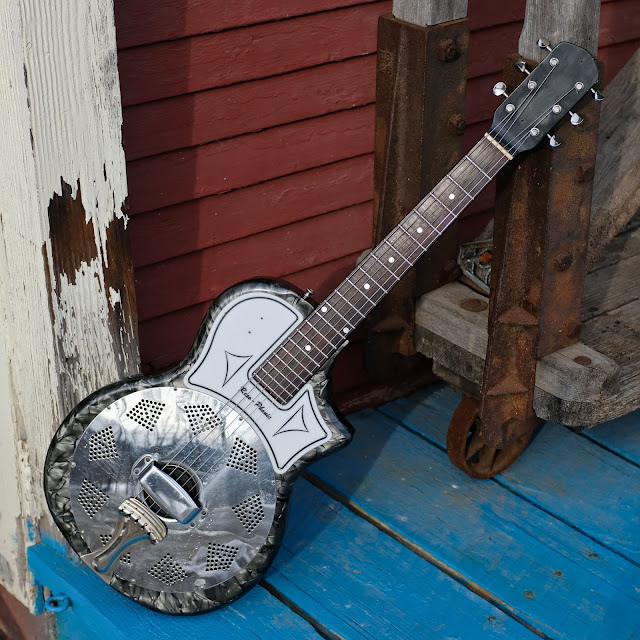1956 National 1133 "Student" Soldibody Resonator Guitar
I've been curious about these guitars for years. I had the chance to try one of them, but its neck was warped beyond use (who knows how that happened as these have stout necks) and its biscuit-bridge was hacked-up so it wasn't really a good indicator of what they could do. This one came in via trade/consignment and, after work, it's really quite an impressive little thing. It has volume and cut like an 0-size flattop (maybe a bit more more cut), but the low E and A strings have a thinner, slappier sound more like a 6-string banjo. It's intriguing to play it because it responds like your average biscuit-cone resonator guitar but the banjo-like, staccato quality to its low-end notes makes you want to play bass-runs in ragtime or country-blues styles.
Compared to its modern relative, the NRP Resolectric, this guitar is quite a lot louder and fuller acoustically -- which is good, because it is, after-all, an acoustic instrument. That's due mostly to the fact that the cone is rear-vented as well. At the end of the post I've included pictures from when I was working on it so you can see the interior layout -- but suffice to say, with that extra volume and body to the guitar coming out of the rear of the cone as well, you get a much better sound. Compared to said Resolectric, it's also a lot weirder, too.
The instrument shares the same 3/4-size "student" neck and a similar body to the National/Supro electric guitars of the time. This means that it has a big, chunky, C-shaped profile on a short, terz-like scale length. That makes the guitar very compact and yet entirely retro. There's the neat innovation of an adjustable-angle set-screw for the neck, which makes action-height adjustments easy -- especially for a player who might like to play this one day "on-the-dot" for chord and single-note work and on another day "jacked-up" for slide playing.
It's also all-original save for a missing National badge at the headstock and pickguard and replaced tuners at the headstock. The body seems to be poplar with mother-of-toilet-seat celluloid wrapping (it looks killer in person), the neck is also probably poplar but has a rosewood fretboard, and the cone is the reduced-sized type commonly seen on the Nat'l resos of this time. Work included a fret level/dress, saddle reshaping and compensation, side dot install, restring with Martin Retro (monel) strings gauged 56w-13, and a good setup. The string gauges need to be heavier for standard tuning at the short scale and you can hear in the video clip above that sometimes I'm banging on it too hard and getting a bit of fret-slap because of the reduced tension. It works the same way on Taylor GS Minis, too...
Specs are: 22" scale, 12" lower bout width, 9" upper bout width, 1 3/4" depth of the body, 1 5/8" nut width, 1 7/16" string spacing at the nut and 2" spacing at the bridge. Action is spot-on with 3/32" EA and 1/16" DGBE at the 12th fret. The neck is straight, has a pretty giant C-shaped back profile, and the board has a ~12" radius to it.
The original nut is bone.
The dots are pearl.
Note that I've strung it up with the strings running under the lip of the tailpiece. This applies a little more down-pressure on the bridge which yields a louder, more projecting tone. It's a personal-preference thing but I think it equates to a better-sounding resonator guitar for most players and it keeps the strings seated better, too.
Under the two pop-on covers in the back there are two bolts. The one closest to the heel tightens the neck to the body and the lower one adjusts neck-angle.
In the above pic you can see the cone in the soundwell with the cover off. Note that in this shot I haven't done any work to the saddle yet.
Here it is with the cone out and showing the lip that it sits in and the backplate cover, too.
And why is this little gem so clean? It has its original case, of course!
























Comments
Mine has a slight bow. I’ve been afraid to do anything because I love mine and don’t want to do anything wrong.
Thank you,
Arlan
Thank you
Greg